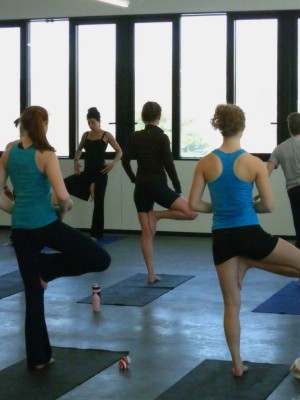
We’re up to the specialty chapters in the blogging tour of my book, “Stretched: Build Your Yoga Business, Grow Your Teaching Techniques.” These chapters break down some of the more specific applications of yoga teaching to several areas, including teaching beginners, corporate yoga classes, private students and students with injuries and specific medical conditions.
Teaching yoga to someone who has never experienced the practice or to someone who is on the newer side of things can be one of the most rewarding experiences for teachers. Beginners tend to make gains quickly, have significant impressions of the practice and can really get excited about the shifts that occur in their body once they start doing yoga. They can also get overwhelmed and confused easily and this can sometimes lead to frustration. This experience can happen with anyone when they try something for the first few times. As with all things, attitude is key and I’ve found that when students approach yoga with little to no expectations and have a personality that allows them to try sometime new with a sense of ease and fun, they will approach it with a lightness that translates into their movements. When someone is Type-A and a perfectionist, or is tied to certain specific outcomes happening as a result of the practice, they can over-think things get in the way of enjoying the practice.
There’s not much you can to change the personality type of your students, but you can certainly keep all of this in mind when you teach beginners. On a very basic level, and keeping the idea of “overwhelm” in mind, we can use instruction and sequencing that is accessible and very clear. We can use language that is to the point, speaks to the body and cuts through the mental chatter that for sure is going on in a beginner’s mind as they start to practice for the first few times. There is always a line though, because the intention is never ever to dilute the practice or speak in silly phrases to anyone (like one might do when teaching kids). However, we don’t want to ramble on and on about how to come into a pose. We want to give 2 or 3 steps and then give them time to be in the pose and breathe.
This chapter is chock full of tips for teaching beginners. I start with “Overall Considerations,” which are some key points to keep in mind when working with beginners. Things such as anticipating what they might be experiencing as you teach a certain pose and adding instruction specific to that action. It’s important to keep away from “feeling” words, like ” You should be feeling,” or “feel” this or that, but instead use action words and phrases. The more we teach, the more we see common trends around improper or unhealthy alignment. These are the things you’d speak to in order to help newer students avoid this at the start.
The chapter then discusses the practice itself and identifies some skills we’re trying to build when teaching beginners. Things like awareness of the breath, knowledge of the poses and an appreciation of stillness are all competencies we want to cultivate in new students. I then discuss the use of props, which are so helpful to ALL students, things to think about in terms of the physical space, the language you use for teaching and physical assisting. I’ve found that new students really appreciate physical assists; not to deepen but to reinforce what you’re saying regarding the alignment of the pose.
Teaching new students can sometimes be overwhelming for teachers. The experience can vary when there are a few new students in a class of more experienced students versus a class of all beginners (some studios have these kinds of classes on their schedule). In either case, you must keep in mind as a teacher that your goal is NOT to work them to perfection. Your only goal, if there is one, is to bring them into a deeper connection to their body. That can be through the breath, through the physical sensations arising in their body as they move from pose to pose and as they connect to the resident strength that already exists within them. Many students come to yoga with a feeling of sadness about how they’ve “let their body go,” how “life has gotten in the way of taking care of themselves,” or how they’ve “put everyone’s needs before their own.” I’ve heard all of these things as I’ve worked with new students. They often see their participation in yoga as a fresh start and as a way to start to get things back on track in terms of their health. We want to be a positive part of that new path, one that inspires, supports and educates.
Next Chapter: Teaching Children’s Yoga.
